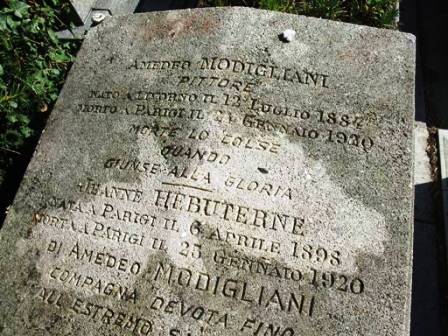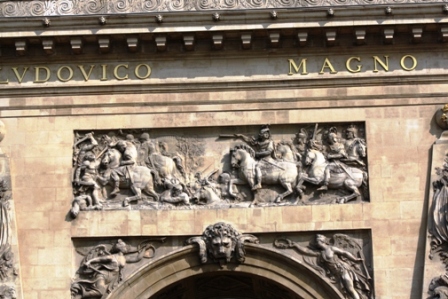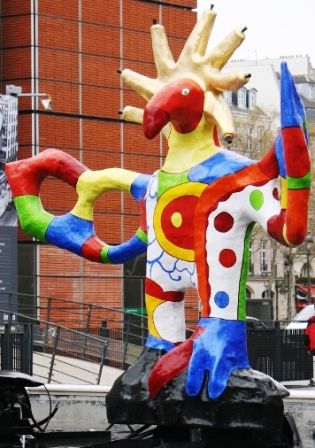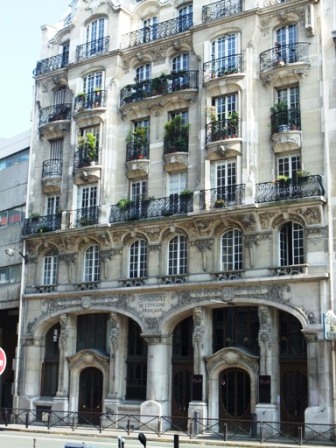|
Paris in the Springtime
Paris France
16-31 March 2011
Paris is for walking tours; Paris is
for Art and Architecture appreciation; Paris is for dining; and for us
Paris is for visiting family. This year March in Paris was a welcome end
for our travels to East Africa.
Spring comes earlier to Paris than
it does in Ottawa. There is no snow, tourist crowds are minimal, the
temperature is moderate, spring flowers are in full bloom and leaves are
popping out on the trees. Yes, we need a warm jacket but it is great
walking weather.
Most days for me started with a croissant run to
one of several boulangeries (bakeries)near the apartment. After that I
liked to walk our two grandsons, Atticus and Roman, to their school.
After Erica and Andrew had left for their jobs, it was time for Ray and
I to consult the guide books that Erica and Andrew have accumulated
during their 3 ½ years in Paris and plot our route for the day. We
sometimes walked straight from the apartment and other times took the
Metro to explore new areas of the city as well as rediscover old
favourites.
Of course the best routes included a good lunch
spot. If it was a sunny day, a sandwich and soft drink bought at a
boulangerie eaten in one of the many parks was just right. Other days we
looked for a restaurant with a special two-course lunch menu.
Restaurants are found on every street corner and are very popular with
Parisians. There is lots of choice. We looked for the “good value”
restaurants away from the touristy area. We had to make sure to choose a
restaurant early in the lunch hour to ensure a seat. The food was
invariably delicious and beautifully presented.
Erica started a new job in early
January as Librarian for the University of London In Paris, located in
the British Council Building, right next door to the Canadian Cultural
Center, overlooking the Esplanade des Invalides. Ray and I accompanied
Erica one morning to the library and were very impressed. She is very
pleased with her job change.
We babysat the two boys the first
weekend while Erica and Andrew flew to Lisbon for a short getaway on
their own. We had a good time with the boys, playing their favourite
card game, Solo, going to the park and swimming in the Montparnasse
public pool on Sunday afternoon. Erica returned Sunday evening, leaving
Andrew in the airport to catch a flight to Botswana where he had
meetings all week.
One of our excursions took us to Père Lachaise
Cemetery in the 20th arrondisement. The cemetery was started by Napoleon
in 1804 to replace a cemetery, next to Les Halles, the city market. The
cemetery had been closed in 1786 for health reasons. Père Lachaise is
full of notable Parisians, including artists, writers, musicians and
Napoleonic military elite. The cemetery is huge, spreading up over a
hill. We got a map showing the location of famous people’s graves.
Everybody else visiting has the same idea. Streets throughout are well
sign posted, as are the divisions within the cemetery. The graves are
all above ground style, with either a raised slab with an inscription or
a family crypt. Most are quite elaborate. The map was quite good but
still required searches to find the exact spot because the graves are so
closely packed together.
The first grave on our list was for
American Jim Morrison, the lead singer of the popular Doors group, who
died in Paris in 1971 of a drug overdose. Fans still visit his grave,
leaving bouquets of flowers and other mementos. We had to wait our turn
to take photos of the grave.
We walked to the northeast corner
to find the grave of Edith Piaf, stopping on the way to see other
notable monuments. A large statue, reminiscent of Rodin’s the Thinker
had the name E Bulgatti inscribed on it but no dates. All the info I
found on the web said Bulgatti, the inventor of the famous racing car
prior to WWII was buried near the Bulgatti plant in Germany. The statue
was impressive anyway.
 Edit Piaf’s grave was hard to find. A
group led by one of the guides offering his services in the cemetery
alerted the rest of us who had been fruitlessly searching.
Nearby we
finally located the grave of Modigliani, the Italian painter. He died of
alcohol and drug abuse in abject poverty in Paris at age 35. He left a
22 year old pregnant common law wife, Jeanne Hébuterne, and a 15 month
old daughter. Jeanne returned to her parents but was so distraught she
jumped from her family’s fifth floor apartment killing herself and her
unborn child three days after Mogdiliani’s death. She is buried next to
her lover. Edit Piaf’s grave was hard to find. A
group led by one of the guides offering his services in the cemetery
alerted the rest of us who had been fruitlessly searching.
Nearby we
finally located the grave of Modigliani, the Italian painter. He died of
alcohol and drug abuse in abject poverty in Paris at age 35. He left a
22 year old pregnant common law wife, Jeanne Hébuterne, and a 15 month
old daughter. Jeanne returned to her parents but was so distraught she
jumped from her family’s fifth floor apartment killing herself and her
unborn child three days after Mogdiliani’s death. She is buried next to
her lover.
We finished by finding the graves of Moliere and La
Fontaine, who were moved to their present site with great fanfare to
publicize the new cemetery. We also found Chopin’s grave and Mano Solo,
an artist who died in 2010 of AIDS.
One of the walking tours in
Paris Access guide book sounded good. We had been to the Place des
Voges, suggested as the start of the walk, but we hadn’t been to the
places at the end of the walk. We took the Metro to the Louvre and made
our way to the Place des Victoires at the confluence of six streets. An
equestrian monument in the center of the square honors King Louis XIV
celebrating the Treaties of Nijmegen, concluded in 1678-79. The original
statue was destroyed in 1792 during the revolution. In 1828, the
restored Bourbon king, Charles X, commissioned the current equestrian
statue of Louis XIV, dressed as a Roman emperor.
The guide book
highlighted Lucien Legrand wine store, in business since 1850, near the
Place des Victoires. We found it in the lovely Gallerie Vivienne, one of
several upscale malls covered with a glass roof, built over one of the
narrow Parisien streets. The store was supposed to have a ceiling
covered with wine corks but it was not visible from the outside. A
notice on the door advertised rather expensive wine tasting and food to
accompany the wines. Ray spotted a bottle of wine in the window from
1916. We wondered if it was still drinkable. A flower store in the mall
caught our eye with a moss covered bicycle decorating the doorway.
 There are two interesting arches in
the area, both constructed on the destroyed medieval walls of the city.
The Roman-style Porte de St Denis was built by Louis XIV to celebrate
his victories in Flanders. Porte de St Martin was added two years later
to announce the grandeur of Paris to visitors arriving from the north at
the very time that Louis XIV was moving the court to Versailles. Nearby
was the elaborate facade of the Renaissance Theatre, constructed in
1872. There are two interesting arches in
the area, both constructed on the destroyed medieval walls of the city.
The Roman-style Porte de St Denis was built by Louis XIV to celebrate
his victories in Flanders. Porte de St Martin was added two years later
to announce the grandeur of Paris to visitors arriving from the north at
the very time that Louis XIV was moving the court to Versailles. Nearby
was the elaborate facade of the Renaissance Theatre, constructed in
1872.
On the way to Les Halles, we took a side trip to visit the
Bourse de Commerce (1887), one of the few buildings to escape demolition
of Les Halles. On the site of an ancient wheat hall, brokers dealt in
wheat, sugar and other commodities. Today it houses the Chamber of
Commerce. The dome is all that remains of the old wheat hall, rebuilt in
metal after a fire in 1802 destroyed the original wooden dome. The
interior of the dome is covered with murals depicting Paris as the
defender of commerce and industry. Next to the Bourse is a 28 m (101-ft)
column topped with a metal cage. The tower was originally attached to
Catherine de Medici’s mansion. She built the Horoscope Tower in 1767 so
that she and her astrologer could climb closer to the heavens and
predict the future.
Les Halles (pronounced Lay Alle), was the
traditional Paris market place. Père Lachaise cemetery replaced an older
cemetery next to Les Halles. Demolished in 1971, the market was replaced
by gardens covering an underground sports complex, shopping mall and RER
train hub. Much of the complex is under reconstruction, scheduled to be
completed at the end of the year. We walked through the garden area that
included a children’s playground that Atticus and Roman would enjoy.
The courtyard of Ste Eustache Church, next to Les Halles, was filled
with people enjoying a picnic lunch in the sun. L'écoute (the listener)
sculpture by Henry Miller, sits outside the church. People crowded
restaurants nearby and a small market with vendors selling take-out
meals filled a side street. We found a booth with good falafel
sandwiches, which we bought and ate sitting in the sun.
After
lunch we followed the suggested route to the Defender of Time clock in
an alley way leading to an apartment complex. It was built in 1975,
modeled on the Rathaus clock in Munich. The oxidized brass sculpture
originally heralded each hour of the day by sending a sword-brandishing
warrior to battle against a bird, a crab and a dragon, representing the
3 elements: air, water and earth at. The faces of the clock have stopped
at two different times, leaving just the figures for us to admire.
The esplanade of the Georges Pompidou Center, near the Clock, was
awash with student groups and buskers. I spied an didgeridoo player
sitting on the concrete playing very well. When asked, she admitted she
was French, not Aussie. I left a tip because it is a difficult
instrument to play and she played very well. A juggler had a large
English speaking school group watch him try to catch a spoon in a cup
balanced on his head. He finally succeeded after several tries. Another
man created giant soap bubbles between two lengths of rope. One man,
sitting peacefully eating a nutritious meal of fruit and veggies, had a
huge pile of junk, his art work, balanced precariously on a shopping
cart beside him. I took his photo and tried to give him a tip, but he
didn’t have a hat or cup ready to accept money.
 Paris is full of fountains that were
recently turned on for the spring season. Another day we returned to the
Pompidou Center with Atticus. He was fascinated with The Stravinsky
fountain, next to the Pompidou Center. Colourful figures, inspired by
Stravinsky’s music, twirl and spout water, making it a child magnet. In
a square next to Stravinsky is the Fountain of the Innocents, a large
sculpture built between 1546 and 1549. It was named after the adjacent
Innocents Church, named after the innocent children killed in Judea by
Herodes. Paris is full of fountains that were
recently turned on for the spring season. Another day we returned to the
Pompidou Center with Atticus. He was fascinated with The Stravinsky
fountain, next to the Pompidou Center. Colourful figures, inspired by
Stravinsky’s music, twirl and spout water, making it a child magnet. In
a square next to Stravinsky is the Fountain of the Innocents, a large
sculpture built between 1546 and 1549. It was named after the adjacent
Innocents Church, named after the innocent children killed in Judea by
Herodes.
Another walk found us at Musée des Arts et Metiers, the
oldest Science and Technology museum in Europe. It was founded in 1794
as a depository for the preservation of scientific instruments and
inventions and housed since its inception in the deserted priory of St
Martin des Champs. We will have to visit the museum another time. We
just went into the inner courtyard and then around to the garden of the
museum where a copy of the Statue of Liberty stands. The statue was the
plaster cast of the eventual full sized Statue of Liberty. After the
sculptor died, the cast was finished and donated to the museum by his
widow.
The 19th C Theatre Gaiete, where comedies and dramas are
still performed, sits across the street from the Museum courtyard. A
pleasant park with a pretty fountain, it is popular with locals enjoying
the spring sunshine.
Erica had suggested we go to Marche des Enfants
Rouge for lunch. Flower and vegetable stalls share space with several
restaurants serving take-out meals. We each chose a plate of tagine; one
with lamb and the other with chicken, which we ate sitting at the tables
in the sun.
Andrew came home Friday morning from his meetings in
Botswana. We gave him a break by decamping to Chenonceaux in the Loire
Valley for the weekend. See the separate blog for details.
We
usually visit at least one museum. I chose the L’Orangerie, an art
gallery on the Place de la Concorde, full of impressionist and
post-impressionist paintings, most from the collection of art patron
Paul Guillaume. The upper floor contains Monet’s tableau of Les Nymphaes
(Waterlillies), inspired by his gardens in Giverny. Monet produced the
canvases during WWI. He envisioned the canvases arrayed in a circle to
create an area of calm as an antidote to the horrors of war. Monday
afternoon there is a guided tour in English. Ray and I would have
benefited more with the English audio guide. Our guide, an art
historian, spoke little English. Ray and I were joined by two British
girls for the 1 ½ hour tour. Ray lasted 20 minutes before excusing
himself and doing his own tour. I did learn a lot from the guide but it
required a lot of patience. I ended up as unofficial translator for the
struggling guide.
Paris is also a city of tourist scams. Beware. We
left the L’ Orangerie to walk through the adjoining Tuilleries garden,
where we spied a woman trying the infamous gold ring scam on
unsuspecting tourists. We had fallen prey to this scam two years ago.
Erica had told us that we were lucky to have escaped by just paying €2
for the worthless “gold” ring. Often there is a pick pocket working with
the Gold Ring person. When I saw the tourists being approached, I called
out “it is a scam”. The tourists quickly left and we were followed and
soundly berated in a language I did not understand for a short distance
by the woman and her partner. They felt cheated of their expected
payment. I was glad to stop the fleecing of tourists.
The next
day Ray went for a walk to the Eiffel Tower. The area is always full of
tourists, souvenir salesmen and con men enticing tourists to bet under
which shell the stone has been placed. He walked home along the Seine
but was stopped on the sidewalk by two scruffy looking men who claimed
they were police. Ray demanded identification. One showed him an arm
band which could have been counterfeit. The other man quickly flashed a
badge but Ray was not satisfied. They spoke only French and Ray’s French
is limited. A couple with a young child was alerted to Ray’s problem and
came to his assistance. It turned out they were genuine police and
wanted to see identification. Apparently this is permitted in France.
The woman who stopped explained to the plains clothed police that this
was not the case in North America. The problem was resolved but be
cautioned. Carrying some sort of photo identification with you in
Europe. You could be asked to produce it.
We ended our visit to
Paris the last evening with a delicious dinner with Erica at an Italian
restaurant near her work place. We will be back exploring more of the
city and of course sampling more of the cuisine.
|
